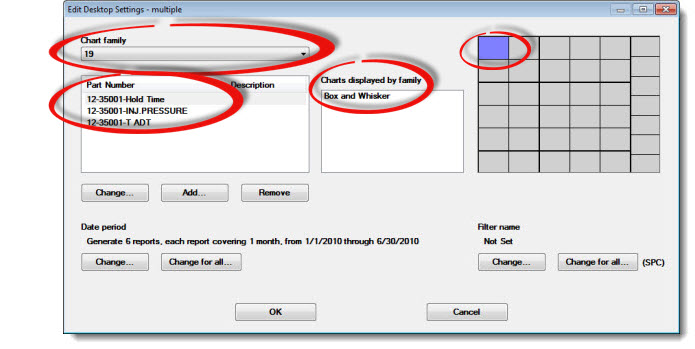
You can open a Desktop with the Edit/Open button to apply different options before the desktop opens.
If this is a Dynamic Desktop, clicking Edit/Open lets you change the settings for the Dynamic Desktop.
If you created this Desktop by Storing Charts and Dashboards as a Desktop, clicking Edit/Open displays the Edit Desktop Settings dialog. This help topic explains how to use this Edit Desktop Settings dialog.
|
Contents [Hide] |
The Edit Desktop Settings dialog allows you to temporarily change part numbers or processes, filters, and date periods for a chart family (and all of its charts) or a retrieval used by dashboard controls on a stored desktop.
In the first example displayed below, Chart family 19 is represented by a Box and Whisker chart that occupies the upper-left corner of the desktop as shown. Chart family 19 has three Part Numbers: 12-35001-Hold Time, 12-35001-INJ.Pressure, and 12-3500001-ADT.

In the next example, the Chart family drop-down list on the Edit Desktop Settings dialog displays a list of numbers (1, 2, 3).

The numbers correspond to each chart family on that particular desktop.* So, if you have one chart family on a desktop for example, the Chart family drop-down list would only display the number 1. If you have three, it would show 1, 2, 3. This helps you to identify the chart groups when using this dialog. As you click each number, the Charts displayed by family list updates to display the chart types that comprise that family. The diagram also updates, displaying the approximate position of the chart family on the desktop.
*If you have dashboards on your desktop, instead of being represented by a number, each dashboard control retrieval will display in the Chart family list with the name that retrieval was given at the time that retrieval was created. For example, if two out of three controls on a dashboard share the retrieval named "ABC" for example, and the third control has the retrieval named "DEF" then, both ABC and DEF would display in the Chart family list for that dashboard since it features those two retrievals (regardless of the number of dashboard controls the dashboard may contain).
In the dialog example above, there are two chart families (represented as 1 and 2) stored on this desktop. Chart family 1 has been highlighted in the Chart family list. The Charts displayed by family field lists a Time Axis Chart as the chart type.* If this chart family also had a Control Chart and a Histogram, for example, those chart types would additionally list in this field.
*If you have dashboards on your desktop, the Charts displayed by family will list only Dashboard as the "chart type." It will not itemize any of the dashboard controls by type that are saved with that dashboard, nor does it reflect the number of dashboard controls associated with that dashboard.
The diagram at far right on the dialog is a spatial representation of the desktop. It shows the approximate placement of any charts or dashboards that occupy a particular desktop. In this example, the Time Axis Chart currently occupies roughly the bottom half of this desktop on which it is stored, as shown on the diagram in which it is represented as the colored rectangle (blue, in this example).
You can also click on a colored portion of the diagram to identify which Chart family and which chart types are associated with a specific desktop locations. The Chart family and Charts displayed by family fields will update with the corresponding information for that position on the chart.
Dashboard retrievals of the type SPC data (scripted) or DMS data (scripted) will not display as a Chart family and cannot be temporarily changed.
Instead of retrieving the data directly from the GainSeeker database with the typical selections of Part Numbers and Processes, Date Period, and Filter (which can be temporarily changed), they use Python scripts to provide the data for the dashboard control.
See:
When you make any temporary changes to a desktop, GainSeeker does not prompt you to save the desktop with those changes.
You can save the modified desktop as a new desktop or overwrite an existing desktop. See Storing Charts and Dashboards as a Desktop
|